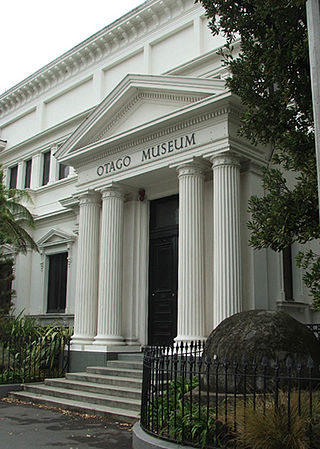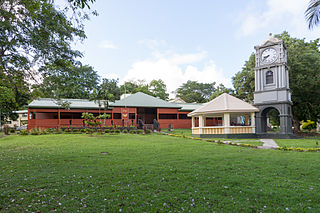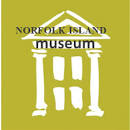
Kiribati, officially the Republic of Kiribati, is an island country in the Micronesia subregion of Oceania in the central Pacific Ocean. Its permanent population is over 119,000 as of the 2020 census, with more than half living on Tarawa atoll. The state comprises 32 atolls and one remote raised coral island, Banaba. Its total land area is 811 km2 (313 sq mi) dispersed over 3,441,810 km2 (1,328,890 sq mi) of ocean.

The Museum Island is a museum complex on the northern part of the Spree Island in the historic heart of Berlin, Germany. It is one of the capital's most visited sights and one of the most important museum sites in Europe. Originally, built from 1830 to 1930, by order of the Prussian Kings, according to plans by five architects, the Museum Island was designated a UNESCO World Heritage Site in 1999 because of its testimony to the architectural and cultural development of museums in the 19th and 20th centuries. It consists of the Altes Museum, the Neues Museum, the Alte Nationalgalerie, the Bode-Museum and the Pergamonmuseum. As the Museum Island designation includes all of Spree Island north of the Karl Leibniz avenue, the historic Berlin Cathedral is also located there, next to the open Lustgarten park. To the south of Leibniz avenue, the reconstructed Berlin Palace houses the Humboldt Forum museum and opened in 2020. Also adjacent, across the west branch of the Spree is the German Historical Museum. Since German reunification, the Museum Island has been rebuilt and extended according to a master plan. In 2019, a new visitor center and art gallery, the James Simon Gallery, was opened within the Museum Island heritage site.

Material culture is the aspect of culture manifested by the physical objects and architecture of a society. The term is primarily used in archaeology and anthropology, but is also of interest to sociology, geography and history. The field considers artifacts in relation to their specific cultural and historic contexts, communities and belief systems. It includes the usage, consumption, creation and trade of objects as well as the behaviors, norms and rituals that the objects create or take part in.

Cultural heritage is the heritage of tangible and intangible heritage assets of a group or society that is inherited from past generations. Not all heritages of past generations are "heritage"; rather, heritage is a product of selection by society.

Repatriation is the return of the cultural property, often referring to ancient or looted art, to their country of origin or former owners.

Tūhura Otago Museum is located near the city centre of Dunedin, New Zealand, adjacent to the University of Otago campus. The museum has one of the largest collections in New Zealand, and is one of the city's leading attractions. Natural science specimens and humanities artefacts from the Otago region and around the world form the basis for long-term gallery displays. An interactive science centre within the museum includes a large, immersive tropical rainforest butterfly house.

The Fiji Museum is a museum in Suva, Fiji located in the capital city's botanical gardens, Thurston Gardens.

The Father Sebastian Englert Anthropological Museum is a museum in the town of Hanga Roa on Rapa Nui in Chilean Polynesia. Named for the Bavarian missionary, Fr. Sebastian Englert, OFM Cap., the museum was founded in 1973 and is dedicated to the conservation of the Rapa Nui cultural patrimony.

The National Museum of Vanuatu is located in the Vanuatu Cultural Centre (VCC) in Port Vila, Vanuatu. It specializes in exhibits relating to the culture and history of this group of islands in the South Pacific. It is unique amongst Pacific national cultural institutions for rejecting many aspects of European museology, and creating new ways of working which value kastom practices.

Alele Museum & Public Library is the national museum and the national archive of the Marshall Islands. It also hosts the only public library in the country.

Oceanian culture encompasses the collective and diverse customs and traditions of art, architecture, music, literature, lifestyle, philosophy, politics and religion that have been practiced and maintained by the many ethnic groups of the geographical region of Oceania since prehistory. Cultures of Oceania reflect not only that of the region's indigenous peoples, but also the cultures brought by European colonisation and the United States, particularly through mass culture such as cinema and TV. Oceania is commonly divided into four geographic sub-regions, characterized by shared cultural, religious, linguistic, and ethnic traits: Australasia, Melanesia, Micronesia, and Polynesia. Most Oceanian countries are multi-party representative parliamentary democracies, and tourism is a large source of income for the Pacific Islands nations.
Anne Haour is an anthropologically trained archaeologist, academic and Africanist scholar. She is Professor in the Arts and Archaeology of Africa at the Sainsbury Research Unit for the Arts of Africa, Oceania and the Americas at the University of East Anglia, Norwich, United Kingdom. In July 2021 she was elected Fellow of the British Academy in recognition of her outstanding contributions to the social sciences, humanities and arts.
Tarisi Vunidilo is a Fijian archaeologist and curator who specialises in indigenous museology and heritage management.
Nauru Museum or Naoero Museum is the national museum of the Republic of Nauru. Located in Yaren, the museum formally opened on 30 January 2019.

The Solomon Islands National Museum is the national museum of the Solomon Islands and is located in Honiara. It is a department of the Ministry of Culture and Tourism.

Falemata'aga - The Museum of Samoa is the national museum of Samoa. It is housed in a former school which was built by the German colonial administration.
Huanaki Cultural Centre & Museum was a national museum and cultural centre in Alofi in Niue, which was destroyed in 2004 by Cyclone Heta.

Tāoga Niue Museum is a national museum and cultural centre located in Alofi, Niue. It replaced the Huanaki Cultural Centre & Museum, which was destroyed by Cyclone Heta in 2004.

Louisa Murdoch Humphry is an I-Kiribati artist and master weaver with over thirty years of experience. Humphry grew up in Kiribati and now resides in New Zealand. In 2019, her work was recognised with a Pacific Heritage Artist Award alongside Kiribati artist Kaetaeta Watson at the Arts Pasifika Awards. In 2021, she was appointed an honorary Member of the New Zealand Order of Merit, for services to the Kiribati community and culture.

Norfolk Island Museum is a museum organisation on Norfolk Island, an external territory of Australia in the southern Pacific Ocean. The museum comprises five sites and collections that include archaeological, archival and social history objects that reflect subsequent waves of forced migration to the island.





















